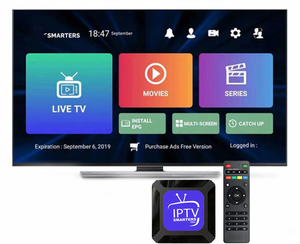Just How IPTV Works: A Step-by-Step Overview to Internet Method Television Innovation
Net Protocol Television (IPTV) has reinvented the method we take in tv material, using a brand-new realm of opportunities with the power of the net. Understanding the ins and outs of just how IPTV functions can shed light on the innovation that drives this innovative form of media shipment. From the fundamental principles of IPTV to the complex procedure of web content distribution, each step plays a crucial function in making sure a smooth viewing experience. In this overview, we will certainly uncover the underlying devices that make IPTV a fascinating combination of modern technology and home entertainment.
IPTV Essentials
In understanding IPTV basics, it is essential to realize the basic operations of this modern technology in supplying tv web content online. IPTV, which represents Net Method Tv, uses Web Protocol (IP) networks to transmit tv web content to customers' tools. Unlike standard techniques of transmitting television web content via cord or satellite signals, IPTV streams media with high-speed web connections.

Furthermore, IPTV permits interactive capabilities, such as video clip as needed (VOD) and electronic program overviews (EPG), improving the user experience by providing more control and versatility in accessing content. On the whole, recognizing the fundamentals of IPTV establishes the foundation for exploring its even more advanced capabilities and the benefits it offers to contemporary television intake.
Content Distribution Process
Efficient material distribution in IPTV systems involves a well-structured process that makes certain seamless transmission of tv web content over IP networks. The content shipment procedure in IPTV starts with the creation of the video material, which is after that encoded into digital style ideal for IP transmission.

Middleware Capability
With the Discover More integration of middleware, IPTV systems gain improved functionality that enhances user communication and content administration. One of the key features of middleware in IPTV is to enable individualized user experiences by supplying features such as interactive program guides, video-on-demand solutions, interactive advertising, and individual choices monitoring.

Gadget Compatibility
Provided the critical role of middleware in enabling seamless communication and web content monitoring in IPTV systems, a critical facet to take into consideration is the compatibility of tools utilized for accessing the IPTV services. Device compatibility is important for guaranteeing a smooth user experience and optimal efficiency when accessing IPTV material.
In the context of IPTV, gadget compatibility refers to the ability of a tool to successfully engage with the IPTV service, display material properly, and support the necessary methods and codecs for streaming video clip content online. Various gadgets, such as wise Televisions, set-top boxes, smart devices, tablets, and computers, might have varying levels of compatibility with IPTV solutions.
To guarantee content a seamless watching experience, it is essential for users to select devices that work with the particular IPTV solution they are utilizing. Furthermore, IPTV company must provide assistance for a wide variety of tools to deal with the varied requirements of their individual base. By prioritizing gadget compatibility, both users and company can boost the overall IPTV experience.
Top Quality of Service (QoS)
Taking into consideration the important role of keeping a high standard of performance and integrity in IPTV systems, guaranteeing regular Quality of Solution (QoS) remains an essential facet of the user experience. QoS in IPTV describes the capacity of the system to deliver material with marginal disruptions, high resolution, and quick filling times. To achieve ideal click now QoS, numerous factors need to be resolved. Network bandwidth is important to sustain top quality video streaming without buffering or pixelation. In addition, latency, jitter, and package loss must be reduced to improve the watching experience.
Provider utilize QoS systems such as traffic prioritization, buffering, and mistake improvement to keep a steady IPTV service. By prioritizing IPTV website traffic over much less time-sensitive data, service providers can ensure smooth playback also throughout height usage hours. Buffering aids make up for network changes, while error improvement methods improve information honesty.
Constant monitoring and optimization of QoS criteria are important to adapt to transforming network problems and user needs. Eventually, a robust QoS structure is crucial for providing a smooth and enjoyable IPTV experience to individuals.
Verdict
In final thought, IPTV runs through the transmission of television web content over internet procedure networks. Top quality of Solution plays an essential function in keeping the efficiency and dependability of IPTV solutions - IPTV subscription.